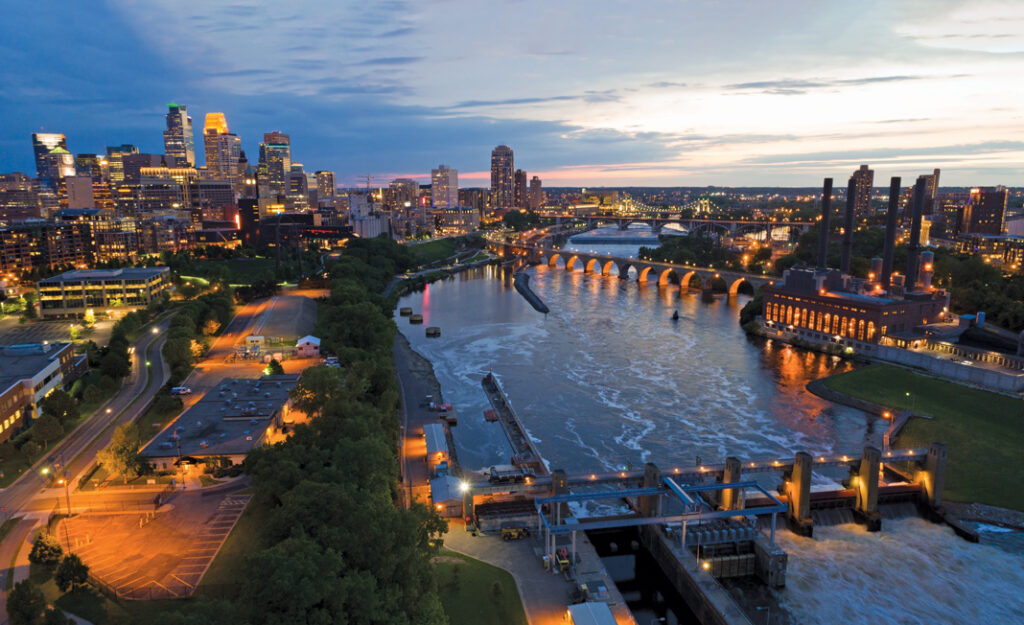Why is Minnesota Called the Twin Cities
Minnesota, a state tucked away in the north of the country, is well-known for its unusual moniker and its Twin Cities, Minneapolis and St. Paul, have evolved into state emblems.
Why is Minnesota Called the Twin Cities

Minnesota, with its stunning scenery, energetic culture, and multicultural neighborhoods, is home to a strange term that has long fascinated locals and tourists alike: the Twin Cities. Minnesota, a state tucked away in the north of the country, is well-known for its unusual moniker and its Twin Cities, Minneapolis and St. Paul, have evolved into state emblems. In order to answer the question, “Why is Minnesota called the Twin Cities?” We will explore the evolution, history, and culture of these two cities in this article.
Why is Minnesota Called the Twin Cities
A Tale of Two Cities: Minneapolis and St. Paul
Geographical Proximity: A Riverine Connection
The phrase “Twin Cities” refers to more than simply Minneapolis and St. Paul’s close vicinity; it also captures the special riverine bond that has played a pivotal role in both cities’ growth and identities. Minneapolis and St. Paul, two cities on opposite sides of the massive Mississippi River, are connected not just by a physical boundary but also by a vital economic and historical corridor.
For the Twin Cities, the Mississippi River has provided opportunity and nourishment as it winds through the center of Minnesota. The early economic prosperity of both towns was largely due to the mills that were powered by the water, which also aided commerce and transportation. The Twin Cities’ development as a single, cohesive entity was made possible by the feeling of dependency this natural relationship fostered.
Historical Roots: Settlers, Immigrants, and Urban Pioneers
We must explore the fascinating history of the immigrants and settlers from the 19th century who established Minneapolis and St. Paul if we are to fully understand why Minnesota is known as the Twin Cities. Drawn by the promise of lush land, copious water supplies, and the opportunity for economic success, pioneers came to the area, creating towns that would later evolve into these two great metropolises.
Minneapolis, located on the west bank, quickly became a major industrial and milling center. Driven by the Mississippi’s flowing rivers, flour mills made the city known as “Mill City,” drawing in European immigrants who were adept at milling as well as native immigrants. Minneapolis’s industrial rise was paved by this flood of varied labor and knowledge.
St. Paul became an important center for trade and transportation on the east bank. Its strategic position at the Mississippi River’s head of navigation made it an ideal entry point for commerce between the developed towns in the east and the western regions. The coming of the railroad further established St. Paul’s position as a transportation junction, linking the hinterlands to booming markets.
Economic Interdependence: Flour Mills and Trade Routes
Their different economic specializations are the foundation of Minneapolis and St. Paul’s economic interdependence. Minneapolis, home to some of the biggest flour mills in the world, came to be associated with the industry. Minneapolis’s milling business became a major participant in the world flour market, not just as a local success but also internationally recognized.
St. Paul was a natural hub for trade and commerce due to its advantageous position at the meeting point of rivers and railroads. The city was essential in enabling the flow of commodities between the Mississippi River and the Great Lakes, acting as a distribution center for western agricultural products. Transportation of commodities played a major role in St. Paul’s economic life, transforming the city into a thriving commercial hub.
The Twin Cities’ economic symbiosis was the result of purposeful cooperation rather than just convenient location. Minneapolis flour made its way to international markets via St. Paul-facilitated transportation networks. The wealth of one city increased the other’s prosperity, starting a cycle of reciprocal reinforcement that set the stage for Minneapolis and St. Paul’s long-lasting collaboration.
There were difficulties in this symbiotic partnership. Relationships between the Twin Cities periodically strained due to competition for labor, resources, and market supremacy. But in the end, their sectors’ complementing qualities and mutual dependence on the Mississippi River created a feeling of mutual benefit that allowed them to live peacefully and sustainably despite swings in the economy.
Twin Cities Moniker: Origins and Evolution
Early References: Seeds of Twinship
The term “Twin Cities” has its roots in the late 19th century, when Minneapolis and St. Paul saw tremendous expansion and development. The phrase first appeared in newspaper articles and commercials, capturing the spirit of the time and the growing awareness of the two cities’ connections.
Both outsiders and locals saw the two cities’ symbiotic connection as the busy mills of Minneapolis hummed with industrial activity and the key trade routes of St. Paul buzzed with commerce. The Mississippi River, which had previously been a natural border, was now a source of economic growth, solidifying the notion that Minneapolis and St. Paul were more than simply adjacent cities; rather, they were inextricably intertwined.
Periodically, publications from the late 1800s referred to the area as the “Twin Cities,” implying that the idea of a shared destiny was beginning to take hold. These early allusions established the foundation for a phrase that would go beyond its geographic roots and become an essential component of the identity of the area.
Development of a Unified Identity: Beyond City Limits
The Twin Cities changed throughout time from being two adjacent cities to creating a one identity that extended beyond the unique qualities of Minneapolis and St. Paul. This shift wasn’t only the product of being close by; companies, people, and civic officials actively worked to create a feeling of community that went beyond the boundaries of the city.
People living in both cities started to see themselves as components of a greater metropolitan area and saw that the wealth of one city was a result of the success of the other. A common identity that transcended local boundaries was established by shared cultural pursuits, economic interests, and community projects. The moniker “Twin Cities” became more than just a descriptive word; it became a representation of the shared past, shared goals, and shared civic pride that united Minneapolis and St. Paul.
After major regional events, there was an especially strong feeling of oneness. Whether they were rejoicing in successes or enduring hardships, Twin Cities citizens found comfort and resilience in their common identity. The prosperity of the Minneapolis flour business or the financial strength of St. Paul’s transportation systems were mutually beneficial accomplishments that reinforced the bonds that united the two cities even more.
Cultural and Recreational Integration: Weaving a Tapestry of Community
The Twin Cities’ blending of culture and pleasure was essential in establishing the area’s standing as a unified whole. Shared places, activities, and institutions developed into the strands that woven a colorful tapestry of community that crossed city lines and produced a common cultural environment.
The Minnesota State Fair is one important organization that had a part in this blending of cultures. Founded in the late 1800s, the fair developed into a yearly event that attracted people from nearby cities as well as other areas. It provided a stage for exhibiting technology advancements, cultural variety, and agricultural successes. The fair, which alternates between Minneapolis and St. Paul, has come to represent common customs and the cooperative nature of the Twin Cities.
The Walker Art Center, founded in Minneapolis in 1879, became another cornerstone of cultural integration. The Walker Art Center, one of the top organizations for modern art in the country, drew tourists from St. Paul and other areas. Its performances, exhibitions, and educational initiatives created a feeling of cultural connectivity among locals with varying creative tastes.
The Chain of Lakes, a natural treasure tucked away in Minneapolis’s metropolitan setting, developed become a popular destination for tourists from both cities. People from Minneapolis and St. Paul alike found common ground in the natural beauty that surrounded them, whether they were riding along picturesque pathways, participating in water sports, or just having picnics by the lakeshores. These common areas served as hubs for the development of a feeling of community that went beyond municipal limits.
The Influence of Twin Cities on Minnesota’s Identity
Economic Powerhouse: Drawing the Map of Prosperity
The Twin Cities’ economic synergy with St. Paul not only made them become a major economic hub, but it also made them attractive to businesses that would have a significant influence on Minnesota as a whole. Due to the dynamic environment this economic interdependence produced, companies and entrepreneurs looking to capitalize on the combined resources, know-how, and infrastructure of both cities were drawn in.
The Twin Cities’ thriving businesses came to represent prosperity in the economy. Minneapolis drew manufacturing companies, digital startups, and financial institutions due to its history as a milling and industrial powerhouse. St. Paul developed as a hub for distribution, trade, and logistics by using its advantageous transit network. The Twin Cities worked together to create a varied economic environment that supported neighborhood communities and spread wealth across the whole state.
This economic power has far-reaching effects outside the cities. Businesses in the Twin Cities prospered because they recruited competent labor, encouraged innovation, and produced employment possibilities. The Twin Cities’ prosperity served as a catalyst for Minnesota’s economic resiliency by building a reputation for efficiency, innovation, and a welcoming business climate that drew talent and capital from around the country.
Educational and Healthcare Hub: Nurturing Minds and Bodies
The Twin Cities have shaped Minnesota’s identity in areas other than the economy, such as healthcare and education. Minnesota has established itself as a center for excellence in these sectors because to the presence of prestigious healthcare facilities like the Mayo Clinic in Rochester and top-tier educational institutions like the University of Minnesota.
The University of Minnesota, which was established in 1851, is evidence of the Twin Cities’ dedication to education. Being one of the top research institutions in the country, it has sparked academic achievement and intellectual creativity. Its innovative research, wide range of programs, and cooperative efforts have not only influenced the Twin Cities’ educational environment but also greatly enhanced the state’s standing as a leader in education.
The Mayo Clinic has a significant influence on healthcare that extends far beyond Rochester. Well-known for its innovative medicine, patient-centered philosophy, and dedication to improving healthcare, the Mayo Clinic works with organizations and professionals all around Minnesota, including the Twin Cities. The state as a whole is now at the forefront of healthcare innovation because to the cooperative efforts in patient care, education, and medical research.
The Twin Cities’ combined impact on healthcare and education has produced a whole ecosystem that supports Minnesotans’ bodies and minds. Graduates from the universities in the Twin Cities work in a variety of sectors, and the state’s hospitals, which treat people all around Minnesota, benefit from the knowledge and innovations that were pioneered there.
Social and Cultural Diversity: Melting Pot of Traditions
The Twin Cities’ thriving cultural scene and warm, inviting vibe have drawn a varied population that adds to the rich fabric of Minnesota’s social environment. The cities have developed into genuine cultural melting pots that promote openness, tolerance, and a love of variety.
In many facets of everyday life, the Twin Cities’ ethnic fabric is visible. The culinary selection has a diverse range of tastes, including classic Scandinavian meals, Hmong specialties, and Somali food. Festivals and events honor cultural customs from throughout the world, presenting art, music, and dance that bring people together and emphasize the distinctive contributions of every ethnic group.
The Twin Cities are home to a wide range of genres and types of artistic expression, with theaters, galleries, and performance venues offering a forum for many viewpoints. In addition to providing entertainment, the Walker Art Center, Guthrie Theater, and many other cultural organizations offer experiences that question preconceived notions and promote a vibrant culture that benefits both locals and tourists.
The Twin Cities’ distinctive ethnic mix has helped to foster an accepting and tolerant environment. The idea that variety is a source of strength that fosters innovation, creativity, and social dynamism rather than just a demographic fact has been accepted by the cities. This welcoming culture has spread across the whole state, influencing Minnesota’s reputation as a location where many cultures live peacefully and strengthening the bonds that bind the Land of 10,000 Lakes.
Challenges and Opportunities for the Twin Cities
Urban Development and Infrastructure
The Twin Cities have grown and developed tremendously, but they also suffer urbanization-related problems. Concerns about things like affordable housing, transportation congestion, and infrastructure needs are constant worries for both city planners and citizens. One of the Twin Cities’ biggest challenges is still juggling the need for sustainable development with the need for continuous expansion.
Socioeconomic Disparities
The Twin Cities, like many other cities, struggle with socioeconomic differences that show up in housing, work, and education. Together with cooperation from the neighboring municipalities, Minneapolis and St. Paul must make a determined effort to address these discrepancies. Making sure that everyone in the community shares fairly in the advantages of economic prosperity is the difficult part.
Climate and Environmental Sustainability
Minnesota’s climate presents particular difficulties, and the Twin Cities are not exempt from the effects of global warming. Proactive action and attention are required for issues including water management, environmental protection, and severe weather occurrences. The Twin Cities’ and the state’s long-term prosperity depend on sustainable practices and a dedication to environmental stewardship.
Conclusion
The term “Twin Cities” captures a remarkable history of development, cooperation, and common identity between St. Paul and Minneapolis. These cities have developed into a vibrant and significant metropolitan region due to their near proximity to one another, historical connection, and cultural integration. Despite its simple beginnings as a description of two nearby cities, the term has come to represent the unity, diversity, and economic strength of the entire state of Minnesota. The Twin Cities’ common identity serves as a source of resilience and strength as they manage the problems of urbanization and socioeconomic inequality. The history of Minnesota as the home of the Twin Cities is a continuous saga that combines community, culture, and history to create a vivid tapestry that captures the essence of the North Star State.
Latest Blog Articles
Connect with Wassup Minnesota
Table of contents
MN News Letter!
Sign up to our newsletter for the best Minnesota content sent directly to your inbox! 😎

